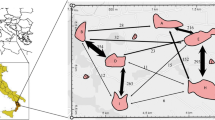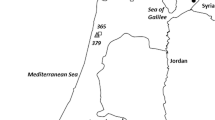Abstract
Seed-mediated gene flow can considerably affect population genetic structure of strictly self-pollinating species, but little is known on the extent and nature of such gene flow among pastoral plant populations. Molecular fingerprints provide a powerful tool to address the relevant issues. Genetic structure of 22 populations of two self-pollinating pasture species, Elymus nutans and E. burchan-buddae, collected from various altitudes of the Qinghai–Tibetan Plateau was studied using fluorescence-based amplified fragment length polymorphism technique. Analysis of molecular variance revealed 42.97% and 37.63% among-population variation for the two Elymus species, respectively, indicating that the majority of the total variation presented within populations. This result contradicts the common genetic variation pattern for a selfing plant species: lower genetic variation within populations. Further analysis suggested higher level of gene flow among populations within the same region than among different regions across the sampled area for the two Elymus species. STRUCTURE analyses of the Elymus populations indicated an evident admixture genetic structure, particularly among neighboring populations from the same region, supporting the hypothesis of considerable seed dispersal among populations. The excess within-region gene flow of E. nutans and E. burchan-buddae might be caused by grazing animals that promote seed dispersal when moved around the pastoral lands during foraging. The among-population gene flow promulgated by grazing animals may promote the maintenance of genetic diversity in the pasture species, particularly in small and fragmented populations within a given region.




Similar content being viewed by others
References
Avise JC (2004) Molecular markers, natural history and evolution, 2nd edn. Sinauer Associates, Sunderland
Bacles CFE, Lowe AJ, Ennos RA (2006) Effective seed dispersal across a fragmented landscape. Science 311:628. doi:10.1126/science.1121543
Bockelmann AC, Reusch TBH, Bijsma R, Bakker JP (2003) Habitat differentiation vs. isolation—musinatedobjectivesby-distance: the genetic population structure of Elymus athericus in European salt marshes. Mol Ecol 12:505–515. doi:10.1046/j.1365-294X.2003.01706.x
Cain ML, Milligan BG, Strand AE (2000) Long-distance seed dispersal in plant populations. Am J Bot 87(9):1217–1227
Chen MJ, Jia ZX (2002) China Forage Flora. China Agricultural Press, Beijing (in chinese)
Chen SL, Xia T, Chen SY, Zhou YJ (2005) RAPD profiling in detecting genetic variation in endemic Coelonema (Brassicaceae) of Qinghai-Tibet Plateau of China. Biochem Genet 43:189–202. doi:10.1007/s10528-005-1511-4
Couvet D (2002) Deleterious effects of restricted gene flow in fragmented populations. Conserv Biol 16:369–376. doi:10.1046/j.1523-1739.2002.99518.x
Darwin C (1859) The origin of species. John Murray, London
Diaz O, Salomon B, Von Bothmer R (1999) Genetic variation and differentiation in Nordic populations of Elymus alaskanus (Scrib ex Merr.) Love (Poaceae). Theor Appl Genet 99:210–217. doi:10.1007/s001220051227
Diaz O, Sun GL, Salomon B (2000) Levels and distribution of allozyme and RAPD variation in populations of Elymus fibrosus (Schrenk) Tzvel (Poaceae). Genet Resour Crop Evol 47:11–24. doi:10.1023/A:1008719119756
Dick CW, Abdul-Salim K, Bermingham E (2003) Molecular systematic analysis reveals cryptic tertiary diversification of a widespread tropical rain forest tree. Am Nat 162:691–703. doi:10.1086/379795
Doyle JJ, Doyle JL (1990) Isolation of plant DNA from fresh tissue. Focus 12:13–15
Eckstein RL, Oneill RA, Danihelka J, Otte A, Kohler W (2006) Genetic structure among and within peripheral and central populations of three endangered floodplain violets. Mol Ecol 15:2367–2379. doi:10.1111/j.1365-294X.2006.02944.x
Excoffier L, Smouse PE, Quattro JM (1992) Analysis of molecular variance inferred from metric distances among DNA haplotypes: application to human mitochondrial DNA restriction data. Genetics 131:479–491
Fahima T, Sun GL, Beharav A, Krugman T, Beiles A, Nevo E (1999) RAPD polymorphism of wild emmer wheat populations, Triticum dicoccoides, in Israel. Theor Appl Genet 98:434–447. doi:10.1007/s001220051089
Falush D, Stephens M, Pritchard JK (2007) Inference of population structure using multilocus genotype data: dominant markers and null alleles. Mol Ecol Notes 7:74–578. doi:10.1111/j.1471-8286.2007.01758.x
Hamrick JL, Nason JD (1996) Consequences of dispersal in plants. In: Rhodes OE, Chesser RK, Smith MH (eds) Population dynamics in space and time. University of Chicago Press, Chicago, pp 203–236
Hamrick JL, Murawski DA, Nason JD (1993) The influence of seed dispersal mechanisms on the genetic structure of tropical tree populations. Vegetatio 108:281–297
Hardesty BD, Dick CW, Kremer A, Hubbell S, Bermingham E (2005) Spatial genetic structure of Simarouba amara Aubl (Simaroubaceae), a dioecious, animal-dispersed Neotropical tree on Barro Colorado Island, Panama. Heredity 95:290–297. doi:10.1038/sj.hdy.6800714
Honnay O, Adriaens D, Coart E, Jacquemyn H, Roldan-Ruiz I (2007) Genetic diversity within and between remnant populations of the endangered calcareous grassland plant Globularia bisnagarica L. Conserv Genet 8:293–303. doi:10.1007/s10592-006-9169-y
Janzen DH (1984) Dispersal of small seeds by big herbivores: foliage is the fruit. Am Nat 123:338–353. doi:10.1086/284208
Jin Y, Lu BR (2003) Sampling strategy for genetic diversity. Biodivers Sci 11:155–161 (in Chinese with English abstract)
Jordano P, Garcia C, Godoy JA, Garcia-Castano JL (2007) Differential contribution of frugivores to complex seed dispersal patterns. Proc Natl Acad Sci USA 104:3278–3282. doi:10.1073pnas.0606793104
Kalisz S, Nason JD, Hanzawa FM, Tonsor SJ (2001) Spatial population genetic structure in Trillium grandiflorum: the roles of dispersal, mating, history, and selection. Evolution 55:1560–1568. doi:10.1111/j.0014-3820.2001.tb00675.x
Kirkpatrick M, Ravigne V (2002) Speciation by natural and sexual selection: models and experiments. Am Nat 159:S22–S35. doi:10.1086/338370
Knapp EE, Rice KJ (1996) Genetic structure and gene flow in Elymus glaucus (blue wild rye): implications for native grassland restoration. Restor Ecol 4:1–10. doi:10.1111/j.1526-100X.1996.tb00101.x
Lu BR (2002) Revision of two Elymus species (Poaceae). Acta Phytotaxon Sin 40:539–545 (in Chinese with English abstract)
Lu BR, Salomon B (2004) Differentiation of the StY genomes in Elymus species as referred by meiotic pairing in interspecific hybrids and its evolutionary significance. Biodiversity Sci 12:213–226 (in Chinese with English abstract)
Pacala SW, Crawley MJ (1992) Herbivores and plant diversity. Am Nat 140:243–260. doi:10.1086/285411
Peakall R, Smouse PE (2001) GenAlEx V5: genetic. Analysis in excel. Population genetic software for teaching and research. Australian National University, Canberra, Australia. http://www.anu.edu.au/BoZo/GenAlEx/
Pritchard JK, Stephens M, Donnelly P (2000a) Inference of population structure using multilocus genotype data. Genetics 155:945–959
Pritchard JK, Stephens M, Rosenberg NA, Donnelly P (2000b) Association mapping in structured populations. Am J Hum Genet 67:170–181. doi:0002-9297/2000/6701-0020
Prittinen K, Pusenius J, Tahvanainen J, Rousi M, Heinonen J, Roininen H (2006) Herbivory modifies the genetic structure of birch populations. Oikos 114:465–470. doi:10.1111/j.2006.0030-1299.14725.x
Russo SE, Portnoy S, Augspurger CK (2006) Incorporating animal behavior into seed dispersal models: implications for seed shadows. Ecology 87:3160–3174
Semagn K, Bjørnstad A, Stedje B, Bekele E (2000) Comparison of multivariate methods for the analysis of genetic resources and adaptation in Phytolacca dodecandra using RAPD. Theor Appl Genet 101:1145–1154. doi:10.1007/s001220051591
Shigesada N, Kawasaki K, Takeda Y (1995) Modeling stratified diffusion in biological invasions. Am Nat 146:229–251. doi:10.1086/285796
Sun GL, Salomon B (2003) Microsatellite variability and heterozygote deficiency in the arctic-alpine Alaskan wheatgrass (Elymus alaskanus) complex. Genome 46:729–737. doi:10.1139/G03-052
Sun GL, Salomon B, Bothmer RV (2002) Microsatellite polymorphism and genetic differentiation in three Norwegian populations of Elymus alaskanus (Poaceae). Plant Syst Evol 234:101–110. doi:10.1007/s00606-002-0211-3
Tallmon DA, Luikart G, Waples RS (2004) The alluring simplicity and complex reality of genetic rescue. Trends Ecol Evol 19:489–496. doi:10.1086/303324
Tero N, Aspi J, Siikamääki P, Jäkäläniemi A (2005) Local genetic population structure in an endangered plant species, Silene tatarica. Heredity 94:478–487. doi:10.1038/sj.hdy.6800642
Vekemans X, Hardy OJ (2004) New insights from fine-scale spatial genetic structure analyses in plant populations. Mol Ecol 13:921–935. doi:10.1046/j.1365-294X.2004.02076.x
Westcott DA, Bentrupperbäumer J, Bradford MG, McKeown A (2005) Incorporating patterns of disperser behavior into models of seed dispersal and its effects on estimated dispersal curves. Oecologia 146:57–67. doi:10.1007/s00442-005-0178-1
Whitlock MC, McCauley DE (1990) Some population genetic consequences of colony formation and extinction: genetic correlations within founding groups. Evolution 44:1717–1724
Wright S (1931) Evolution in Mendelian populations. Genetics 16:97–259
Wu ZY, Peter HR, Hong DY (2006) Flora of China- Poaceae vol. 9. Science Press, Beijing
Yan XB, Guo YX, Zhou H, Lu BR, Wang K (2006) Genetic patterns of ten Elymus species from Tibetan and Inner Mongolian Plateaus. Grass Forage Sci 61:398–404. doi:10.1111/j.1365-2494.2006.00547.x
Yan XB, Guo YX, Zhao C, Liu FY, Lu BR (2009) Intra-population genetic diversity of two wheatgrass species along altitude gradient on the Qinghai-Tibetan Plateau: its implication for conservation and utilization. Conser Genet 10:359–367. doi:10.1007/s10592-008-9596-z
Zhao QF, Wang G, Li QX, Ma SR, Cui Y, Grillo M (2006) Genetic diversity of five Kobresia species along the eastern Qinghai-Tibet Plateau in China. Hereditas 143:33–40. doi:10.1111/j.2006.0018-0661.01924.x
Zhao C, Liu FY, Guo YX, Yan XB (2007) Comparison between fluorescence labeling and silver-staining techniques of AFLP. J Gansu Agric Univ 42:125–129 (in Chinese with English abstract)
Acknowledgments
This study was supported by the Ministry of Science and Technology (No. 2001CB711103) and National Natural Science (30871531 and 30600033) of China. We are grateful to Prof. K Wang, Z He, and Dr. SY Wang of the Institute of Grassland Sciences, China Agricultural University, Mrs. AQ Gong, YX Xu, H Chang, L Dan, and H Li of the Grassland Management Bureau of Qinghai Province, and Mr. B Ning of the Grassland Management Station of Maqin County, Qinghai Province for their comments and extensive assistance in the field.
Author information
Authors and Affiliations
Corresponding author
Rights and permissions
About this article
Cite this article
Yan, XB., Guo, YX., Liu, FY. et al. Population structure affected by excess gene flow in self-pollinating Elymus nutans and E. burchan-buddae (Triticeae: Poaceae). Popul Ecol 52, 233–241 (2010). https://doi.org/10.1007/s10144-009-0169-x
Received:
Accepted:
Published:
Issue Date:
DOI: https://doi.org/10.1007/s10144-009-0169-x




